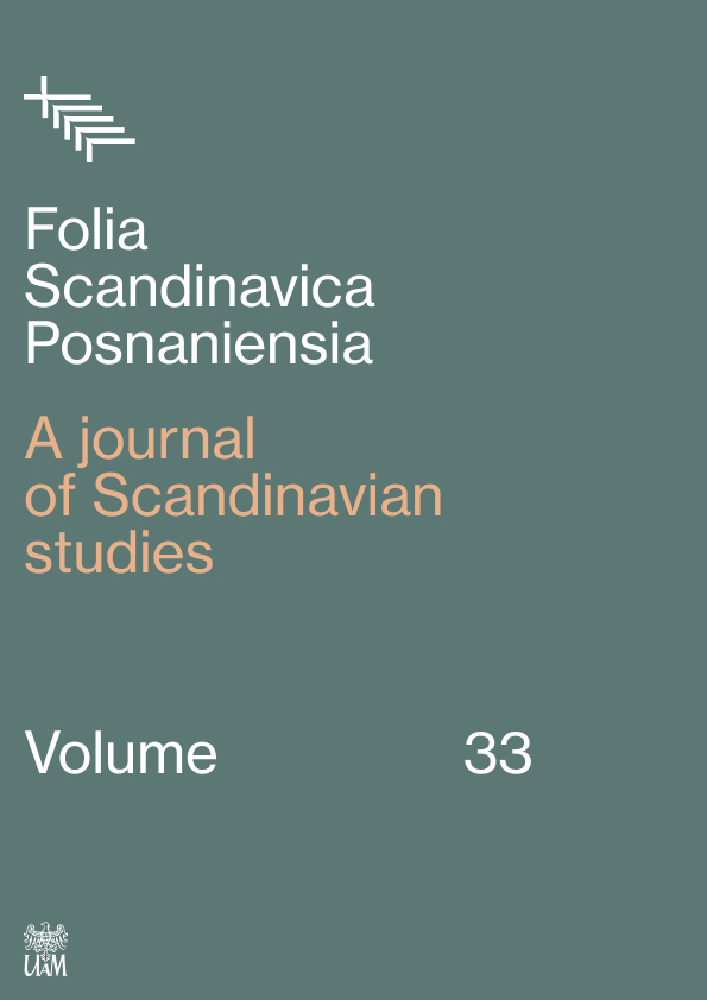Abstract
This longitudinal study explores two specific aspects of the acquisition of grammatical gender in L2 Swedish: the use of a default gender and surface transfer. Twenty-one L1 Polish university students of L2 Swedish were tested by means of an untimed gender assignment task after two, three, and four semesters of studying. The data were analysed using a two-way ANOVA for repeated measures. Participants had more success in assigning gender to Swedish nouns that shared gender across Polish and Swedish than to Swedish nouns that differed in gender across the two languages, regardless of length of experience in learning Swedish. Contrary to previous studies that observed overgeneralisation of uter gender forms in production, this study did not identify the tendency to use uter as a default, presumably because participants had unlimited time to perform the task. This finding points to a dissociation between the knowledge of grammatical gender and the ability to use it during processing.
Funding
National Science Centre, Poland (grant number 2019/33/N/HS2/00349)
References
Alarcón, I. V. (2011). Spanish gender agreement under complete and incomplete acquisition: Early and late bilinguals’ linguistic behavior within the noun phrase. Bilingualism: Language and Cognition 14(3), 332–350. DOI: https://doi.org/10.1017/S1366728910000222
Andersen, R. (1984). What’s gender good for, anyway? In: R. Andersen (ed.), Second languages: A cross-linguistic perspective (pp. 77–99). Rowley, MA: Newbury House.
Andersson, A.-B. (1992). Second language learners’ acquisition of grammatical gender in Swedish. Doctoral dissertation. University of Gothenburg.
Bianchi, G. (2013). Gender in Italian–German bilinguals: A comparison with German L2 learners of Italian. Bilingualism: Language and Cognition 16(3), 538–557. DOI: https://doi.org/10.1017/S1366728911000745
Bohnacker, U. (2003). Nominal phrases. In: G. Håkansson, G. Josefsson & C. Platzack (eds.), Acquisition of Swedish grammar (pp. 195–259). Amsterdam: John Benjamins. DOI: https://doi.org/10.1075/lald.33.08boh
Bordag, D. & Pechmann, T. (2007). Factors influencing L2 gender processing. Bilingualism: Language and Cognition 10(3), 299–314. DOI: 10.1017/S1366728907003082. DOI: https://doi.org/10.1017/S1366728907003082
Carroll, S. (1989). Second-language acquisition and the computational paradigm. Language Learning 39(4), 535–594. DOI: https://doi.org/10.1111/j.1467-1770.1989.tb00902.x
Corbett, G. G. (1991). Gender. Cambridge: Cambridge University Press. DOI: https://doi.org/10.1017/CBO9781139166119
Dewaele, J.-M. & Véronique, D. (2001). Gender assignment and gender agreement in advanced French interlanguage: A cross-sectional study. Bilingualism: Language and Cognition 4(3), 275–297. DOI: https://doi.org/10.1017/S136672890100044X
Ellis, C., Conradie, S. & Huddlestone, K. (2012). The acquisition of grammatical gender in L2 German by learners with Afrikaans, English or Italian as their L1. Stellenbosch Papers in Linguistics 41, 17–27. DOI: https://doi.org/10.5774/41-0-131
Franceschina, F. (2001). Morphological or syntactic deficits in near-native speakers? An assessment of some current proposals. Second Language Research 17(3), 213–247. DOI: https://doi.org/10.1177/026765830101700301
Hardison, D. M. (1992). Acquisition of grammatical gender in French: L2 learner accuracy and strategies. The Canadian Modern Language Review 48(2), 292–306. DOI: https://doi.org/10.3138/cmlr.48.2.292
Kilgarriff, A., Charalabopoulou, F., Gavrilidou, M., Johannessen, J. B., Khalil, S., Kokkinakis, S. J., Lew, R., Sharoff, S., Vadlapudi, R. & Volodina, E. (2014). Corpus-based vocabulary lists for language learners for nine languages. Language Resources and Evaluation 48, 121–163. DOI: https://doi.org/10.1007/s10579-013-9251-2
Klassen, R. (2016). When masculine as default supercedes L1 transfer: Bilingual speakers of languages with asymmetric gender systems. In: A. Alba de la Fuente, E. Valenzuela & C. Martínez Sanz (eds.), Language acquisition beyond parameters: Studies in honour of Juana M. Liceras (pp. 73–98). Amsterdam: John Benjamins. DOI: https://doi.org/10.1075/sibil.51.04kla
Kupisch, T., Akpinar, D. & Stöhr, A. (2013). Gender assignment and gender agreement in adult bilinguals and second language learners of French. Linguistic Approaches to Bilingualism 3(2), 150–179. DOI: https://doi.org/10.1075/lab.3.2.02kup
Lemhöfer, K., Spalek, K. & Schriefers, H. (2008). Cross-language effects of grammatical gender in bilingual word recognition and production. Journal of Memory and Language 59(3), 312−330. DOI: https://doi.org/10.1016/j.jml.2008.06.005
Lemhöfer, K., Schriefers, H. & Hanique, I. (2010). Native language effects in learning second-language grammatical gender: A training study. Acta Psychologica 135(2), 150−158. DOI: https://doi.org/10.1016/j.actpsy.2010.06.001
Nyqvist, E.-L. & Lahtinen, S. (2021). Grammatical gender in L2 Swedish in Finnish-speaking immersion students: A comparison with non-immersion students. Nordic Journal of Linguistics 44(3), 281–303. DOI: https://doi.org/10.1017/S0332586520000256
Paolieri, D., Cubelli, R., Macizo, P., Bajo, T., Lotto, L. & Job, R. (2010). Grammatical gender processing in Italian and Spanish bilinguals. Quarterly Journal of Experimental Psychology 63(8), 1631–1645. DOI: https://doi.org/10.1080/17470210903511210
Sabourin, L., Stowe, L. A. & de Haan, G. J. (2006). Transfer effects in learning a second language grammatical gender system. Second Language Research 22(1), 1–29. DOI: https://doi.org/10.1191/0267658306sr259oa
Sá-Leite, A. R., Luna, K., Fraga, I. & Comesaña, M. (2020). The gender congruency effect across languages in bilinguals: A meta-analysis. Psychonomic Bulletin & Review 27, 677–693. DOI: https://doi.org/10.3758/s13423-019-01702-w
Schriefers, H. & Jescheniak, J. D. (1999). Representation and processing of grammatical gender in language production: A review. Journal of Psycholinguistic Research 28, 575–600. DOI: https://doi.org/10.1023/A:1023264810403
Skrzypek, D. (2010). Interactions of grammatical categories: how three genders became two. European Journal of Scandinavian Studies 38(1), 91–106. DOI: 10.1515/ejss.1.2008-2010.009. DOI: https://doi.org/10.1515/ejss.1.2008-2010.009
Stefańczyk, W. T. (2007). Kategoria rodzaju i przypadka polskiego rzeczownika: próba synchronicznej analizy morfologicznej. Kraków: Wydawnictwo UJ.
Stöhr, A., Akpinar, D., Bianchi, G. & Kupisch, T. (2012). Gender marking in L2 learners and Italian-German bilinguals with German as the weaker language. In: K. Braunmüller & C. Gabriel (eds.), DOI: https://doi.org/10.1075/hsm.13.11sto
Multilingual individuals and multilingual societies (pp. 153–170). Amsterdam: John Benjamins.
Sunderman, G. & Kroll, J. F. (2006). First language activation during second language lexical processing: An investigation of lexical form, meaning, and grammatical class. Studies in Second Language Acquisition 28(3), 387–422. DOI: https://doi.org/10.1017/S0272263106060177
White, L., Valenzuela, E., Kozlowska-Macgregor, M. & Leung, Y.-K. I. (2004). Gender and number agreement in nonnative Spanish. Applied Psycholinguistics 25(1), 105–133. DOI: https://doi.org/10.1017/S0142716404001067
License
Copyright (c) 2023 Kamil Długosz

This work is licensed under a Creative Commons Attribution 4.0 International License.

